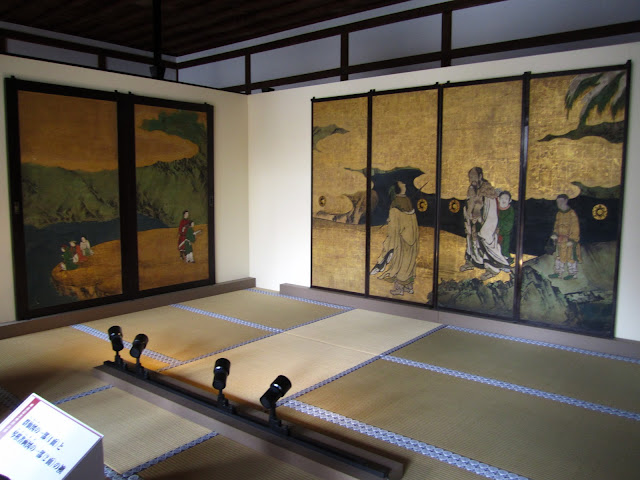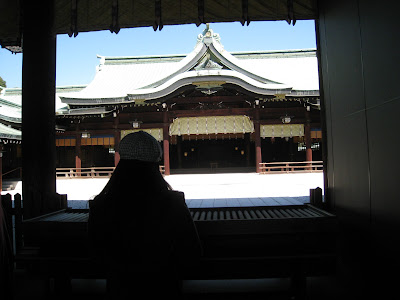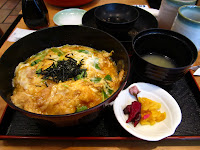My apologies in advance to anyone using dial-up or who has a slow internet connection. This will be a very graphic-intensive post with lots of photos (as with all of my updates, lol). I'm sorry if all of the photos don't load for you, I wanted to incorporate them into the body of my entry so that you can follow along with me as I talk about each stop.
Kyoto was by far my favourite stop on our short trip, as it is a culturally rich town full of old temples hidden amongst the houses, just waiting to be discovered. We didn't know where to start, so we figured we would start with the biggest attraction (Kinkakuji) and work our way backwards. That way, if we didn't get to see more of the city, we thought we would at least have that one under our belts.
First, breakfast at the Crepe place in the food court of the shopping mall down the street from us. We had been eyeballing those crepes the night before when we were in there for dinner, and since they had both dessert and breakfast crepes, we figured it was the perfect start to our day. And it was. Yummm.
Before we left the hotel we asked the front desk how to get to Kinkakuji, which on the North side of Kyoto. She showed us which busses we could take, so off we went to Kyoto Station to catch the bus. How hard could it be, right? Well..... turns out what we thought was the bus terminal was actually just the airport bus pick-up with a few other city busses stopping there, and all the signs were in Japanese so we were thoroughly confused. Managed to ask a police officer nearby where we might find an Info booth (put our favourite phrase to good use again - "Ego wakarimasu ka?"). He pointed us into the station... Who here has been to Kyoto Station? That place is MASSIVE! It is at least 12 stories tall not including the basement shops, it has multiple indoor shopping complexes, restaurants galore, and the whole station is very sleek and modern. Not the busiest station we encountered on our trip, but then again these weren't exactly normal circumstances.
 |
| This is only from the 3rd platform, there are another 8 levels above/behind us |
Anyhow, we found the bus, took us about 30-35 mins to get to Kinkakuji. The bus system is so neat, they have announcements in Japanese, English, and Chinese, and the lady not only announces what stop you're at but also what stop comes next and all the major attractions in the area with some background info on each one. That was the only reason I found this next temple - one of my favourite little shrines tucked away between two buildings as we were walking down the street.
The following photos are from Wara Tenjin Shrine, which I understand is for easy childbirth and possibly fertility as well. I think, based on what little information I was able to gather,
tenzin or
tenjin means straw? And based on how the straw is laid out, the Gods are able to tell an expectant mother whether she is having a boy or a girl. I also think you can make sake offerings for plentiful lactation. Very interesting to say the least. I was caught a little off guard by the baby bibs, as part of the reason that we decided to return home when we did was because I was reminded that although radiation exposure might not seem like a big deal at the moment, the potential harm down the road is far more dangerous, particularly in terms of my future ability to have children. So of course as I approached the altar, said my prayers, and saw the bibs, I immediately started bawling. As one of my best friends always tells me, everything happens for a reason and I think this was the last sign telling us it was time to go home.
(Not to get all academic on you but one of my former UoG profs posted a short article on his website about
risk perception, if you're interested in reading it I found it really enlightening and very applicable to our situation in Japan.)
 |
| Performing the washing ritual before entering the temple |
 |
| Beautiful springtime display |
 |
| Baby bib offerings |
I think I'm talking too much, so I'm going to try to tone it down a little. I think the next series of photos is pretty self-explanatory anyway. We arrived at Kinkakuji Temple (The Golden Pavilion) with a handful of other tourists, but the grounds themselves still seemed relatively deserted compared to what we were expecting. As usual, it was eerily quiet in all of the temples, the grounds were so big you couldn't even hear the normal city sounds from where we were.
We could see this symbol etched into the mountain, I'm not entirely sure what it means but if it is what I think it is, I think it means "big" or "great"? Please correct me if I'm wrong!
The Golden Pavilion was just as gold and just as beautiful as it is in photos.
We had lunch next, because we got lost looking for Ryoan-ji Temple (turns it it was 1.6km down the street...). Found a tiny little restaurant off one of the main streets and ordered the two things we knew the names of -
tempura udon and
oyako donburi. It was wonderfully delicious. And I had my first (and only) experience with one of the Japanese squat toilets at that restaurant. How's that for enculturation?
We eventually found Ryoan-ji Temple, which was situated on 120 sprawling acres of beautifully landscaped gardens and orchards. This temple is most famous for the Zen Rock Garden, one of the most tranquil places on earth.
 |
| This was the first (and only) place we had to remove our shoes so far |
"The Zen garden is an austere arrangement of 15 rocks rests on a bed of white gravel, surrounded by low walls. The moss-covered boulders are placed so that, when looking at the garden from any angle, only 14 are visible at one time. In the Buddhist world the number
15 denotes completeness. So you must have a total view of the garden to make it a whole and meaningful experience, and yet, in the conditions of this world, that is not possible." (As quoted from
Sacred Destinations)
 |
| This photo doesn't do it justice |
 |
| Note the buckets: think that would pass Canadian fire safety codes? |
 |
| Self-portrait under the tori in the gardens in the middle of the lake at Ryoan-ji |
 |
| We did see a few early blooms while we were there |
In this photo you see two traditional screens that depict the "Four Accomplishments" and the "Immortals". The Immortals refers to the Chinese Immortals, and it is said that in order to be considered a wise man, one must first achieve the four accomplishments - playing zither, mastering chess, and practicing painting and calligraphy. These two themes have been used in paintings for folding screens and sliding doors since the 14th Century. These particular pieces were on display to celebrate their return to Ryoanji after 115 years (there are 6 in total).
Our last stop on our Kyoto tour was the Ninna-ji Temple. We had done quite a bit of walking by this point, and the skies were turning grey, but I'm glad we made it to this one before we had to turn in for the day. It was a little bittersweet too because this turned out to be our last stop on our Japan tour as we made the decision that afternoon to return home the next day.
This particular Temple was even bigger and more deserted than the other ones we visited. It was hauntingly beautiful, being less "polished" than some of the other places we visited. This temple was completed in the year 888, but was destroyed by fire and fighting during the Onin War in 1467. It was rebuilt with the help of the Shogun approximately 150 years later, around the same time they rebuilt the Imperial Palace in Kyoto.
 |
| Front entrance |
It was set at the foot of the mountains on the outskirts of Kyoto, so who knows how far the grounds extended beyond what we explored.
 |
| It just went on and on |
This 5 story pagoda was constructed in 1644, it is 36.18m tall, and the particularity of it is that from top to bottom you can barely see any difference in width.
That basically concludes our journey through Japan. We went back to the hotel after our long day of sightseeing, did some last minute shopping, and had a really delicious dinner at a katsu restaurant we were dying to try. They also didn't speak English there, so Dad ended up taking the waiter outside to point to the special we wanted. It was sooo much food but sooo good.
 |
| 3 types of breaded meat (pork, hamburger, shrimp), homemade tonkatsu sauce, rice, miso soup, OISHII! |
Thank you for following along with me as I journeyed through Japan. As I've said many times in the last week - we're just itching to get back there, hopefully we can go back in the fall when the nuclear threat has subsided and regular travel has resumed. My love affair with Japan has only just begun. <3



















































